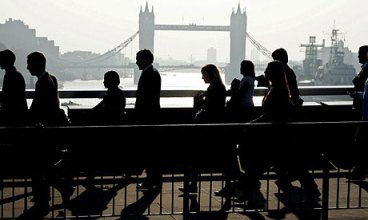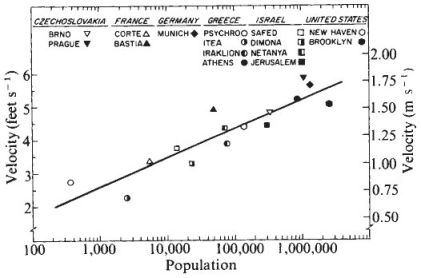Late last week [The Atlantic’s] Richard Florida wondered on Twitter whether pedestrian walking speeds might indicate a city’s economic activity — reflecting some sort of “urban metabolism,” as he put it. Turns out there’s a rather long history of research into the speed of walking in cities, and that the evidence reveals, among other things, a strong connection between fleetness of foot and fatness of wallet. Call it a sign of the Cantering Class.
Most work on urban walking speed dates back to 1976, when psychologists Marc and Helen Bornstein published a provocative paper on the topic in the top-tier journal Nature. The Bornsteins wanted to understand the relationship between a growing human population and an individual person’s behavior. So they planted themselves in major activity centers of 15 different cities and towns in six different countries on warm sunny days, and timed how fast a couple dozen solitary, unsuspecting pedestrians covered about 50 feet of space.
The resulting correlation between walking speed and population was strikingly linear. With only a couple exceptions, people in places like Brooklyn, New York (pop: 2.6 million), walked faster than those in places like Psychro, Greece (pop: 365). The analysis indicated not only that life moves faster in the city than in the countryside, but that “pace of life varies in a regular fashion with the size of the local population, regardless of the cultural setting,” the Bornsteins reported:
The Bornsteins suggested that the intense interpersonal crowding of cities might trigger behaviors that reduced “social interference,” such as walking quickly. Other psychologists at the time bought into this idea: Stanley Milgram, for instance, believed that the sensory overload of the city prompted a social withdrawal response — in this case, a rapid motor action — to limit a person’s environmental stimulation.
In 1989 the geographers D. Jim Walmsley and Gareth Lewis pointed out some flaws in the “cognitive overload” theory. For starters, some people obviously thrive on an active, stimulating environment. Besides that, a very slow pace of life no doubt creates cognitive and behavioral changes of its own. So Walmsley and Lewis set out first to validate the Bornsteins’s results, and, if they held true, to propose some reasons for urban walk speed of their own.
The first goal was easy enough. Walmsley and Lewis timed 1,300 pedestrians in 10 places in England and Australia, from London (pop: 6.7 million) to Glen Innes (pop: 6,000). In line with the previous work, the researchers found that the bigger the city, the faster the walkers — though the effect was not quite as profound as it had been in the Bornstein study. Still Londoners in the morning had a study-high walking speed of 1.68 meters per second, Walmsley and Lewis reported in the journal Environment and Behavior.
As one possible explanation for the relationship between city size and foot speed, the researchers suggested that economic factors might play a key role. When a city grows larger, they wrote, wage rate and cost of living increase, and with that the value of a resident’s time. As a result, “economizing on time becomes more urgent and life becomes more hurried and harried,” Walmsley and Lewis suggest.
The link between time, money, and walking earned even more validity in a seminal 1999 study led by psychologist Robert Levine of California State University at Fresno. Levine studied what he broadly called “pace of life” in various cities — typically the largest ones — from 31 countries around the world. Writing in the Journal of Cross-Cultural Psychology, Levine explained that he simply wanted to know what other cultural factors, beyond simple population size, influenced the speed of urban pedestrians.
Levine measured three “pace of life” variables — walking speed, work speed, and clock accuracy — though for the purposes of this post, in keeping with the previous literature, we’ll focus on the first. The top ten cities for walking speed, according to Levine, were as follows: Dublin, Amsterdam, Bern/Zurich, London, Frankfurt, New York, Tokyo, Paris, Nairobi, and Rome.


Discussion
No comments yet.